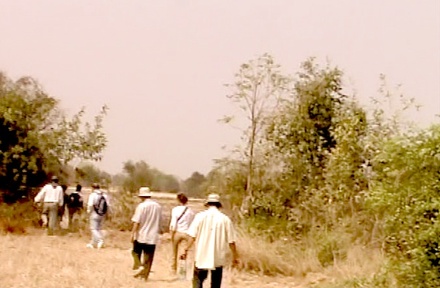| BANYAN BLOG |
banyan blog
 Finding the graves back in Battambang. Feb 14, 2004. © Banyanblog. Finding the graves back in Battambang. Feb 14, 2004. © Banyanblog. The sun was beating down on us that long February afternoon in 2004. Even though it was technically the “cool season” in Cambodia, being out in the open and dry fields for hours took a toll on our bodies. We were thirsty, hot, sweaty and disoriented. I wondered, what are we even doing here? Then I looked around and realized the crossroads of fate was standing right in front of me. We were meant to be here. Destiny brought me back to Battambang, to Oak-a-bao, the Khmer Rouge camp I was born in over 20 years later. But seeing my birthplace was not the purpose of our visit. We were there to find the burial site of my family members who had died during the “bad times”. I will never forget my first visit back to Battambang, our visit back to Oak-a-bao. We were all looking for closure, all in our own way. On a Mission Battambang was not on my itinerary during that first visit back to Cambodia. Instead, I had planned to come back to Phnom Penh to meet up with colleagues after a short excursion in Siem Reap. There was an opportunity to see a work project but the site visit was rescheduled for another time. Before I knew it, I was in the van with my family on the bumpy road to Battambang. Battambang was always on my uncle’s itinerary on this visit to Cambodia. My uncle, whom we called Pa Om (my mother’s brother), and his wife, left Cambodia to the U.S. in 1980. They settled down in Northern Virginia and we followed a year later. He was always playful, but a man of a few words. He was never comfortable being at the center of attention, just like my grandmother, Yey Eng. My father and Pa Om were classmates since they were teenagers and subsequently became brothers through marriage. It was Pa Om and his family we were seeking to follow when my father asked to move from Takeo to Battambang in 1975. Although we went to find them, we ended up at different camps. Something about the past still haunted my uncle. Something he wanted closure from. The only reason he wanted to come back to Cambodia on this trip, was to go to back to Battambang, to go to Oak-a-bao, and find the graves of his parents, he told us. My parents, Pa Om and his wife first returned to Cambodia in 1996. During that time, Cambodia was still unsafe to venture outside of Phnom Penh, despite a few years after the Paris Peace Accords and the presence of United Nations Transitional Authority in Cambodia (UNTAC), to help with a transition thereafter. There were still pockets of Khmer Rouge strongholds, especially outside of Phnom Penh, and millions of landmines scattered throughout the countryside. Although he was in Battambang visiting his wife’s family, as much as he would have like to, my uncle knew it was too dangerous to go deep into the woods of Oak-a-bao, to try to find the graves back then. He also didn’t know where to go since my parents didn’t go to Battambang with them at the time. Eight years later the situation changed. The country was safer, more peaceful and stable. The Khmer Rouge movement had been virtually eradicated. With international assistance, Cambodia destroyed millions of landmines from the countryside. My parents also went to Battambang this time. Fate brought us all back to Battambang when the timing was right. A Family Torn Apart In April 1975, the Khmer Rouge evacuated my family from Phnom Penh to Takeo. We eventually settled in Battambang at the end of October. In the years leading up to the evacuation, villages were being destroyed by the constant secret U.S. bombing campaign, which started in 1969 in the Cambodian countryside. Innocent Cambodian civilians were the casualties of war in Vietnam. Then the Lon Nol coup occurred in 1970 and the civil war spiraled Cambodia out of control. For five years, fighting took place outside of Phnom Penh between the Lon Nol government and the Khmer Rouge. These two powerful dynamics pushed villagers from the countryside into Phnom Penh. My grandparents (my mother’s parents) and both of my uncles’ families, Om Ngat and Pou Sean (my dad’s youngest brother) all migrated from Takeo to Phnom Penh to escape the violence. Pa Om and his family were already living in the capital. When the Khmer Rouge took over, my immediate family, grandparents and uncles, including Pa Om’s family, all evacuated Phnom Penh to Takeo. There, we all eventually parted ways. Pou Sean and Om Ngat stayed in Takeo, while Pa Om’s family left for Battambang, which was his wife’s home province. That was the last time my uncles (Pa Om and Om Ngat) saw their parents. It was also the last time we ever saw my uncles until after the war. We eventually reunited with Pa Om at my aunt’s childhood home in Battambang in 1979. It took over 20 years before my parents saw their other brothers again. My grandparents, Kong Sreng and Yey Eng (my mom’s parents) stayed with us in Battambang. For a few short months we were allowed to stay together as a family. But that didn’t last very long. My mother recalls, that at the beginning of the regime, the Khmer Rouge didn’t make children work in the fields at Battambang. In early 1976, that policy changed and the two older boys (Sovanna and Sovannara) were forced to join the Koma Chhean Mok, the youth camp, to do hard labor in the front fields (digging and plowing). The two younger boys (Sakeda 11 and Soleil 8) were sent to Koma Mondul (the children’s camp). My parents, sister and I stayed in the same hut. My father begged Kane, the Khmer Rouge commune leader, to have my brother Soleil to stay with him since he was so young. He agreed to the villagers’ dismay. They were already jealous of Kane’s favoritism towards my father. Kong Sreng and Yey Eng My grandfather’s name was Sreng whom we also called Kong Sreng. He was very tall and liked to talk. He was the son of a Chinese farmer whose ancestors migrated from Southern China and settled in Takeo. My grandmother’s name was Eng Keat whom we also called Yey Eng. She was beautiful and a woman of very few words. Kong and Yey had four children, three boys and one girl. During the Khmer Rouge regime they stayed with their daughter, Sakhan, (my mother) in Battambang. The oldest son was in Takeo, and the second son was at a different camp in Battambang. The youngest in the family, Nam Heng, was in the Lon Nol army in Battambang before the war. When the Khmer Rouge took over, they rounded up the soldiers stationed there and told them that they had to go to the airport to welcome Prince Sihanouk back to the country. His family never saw him again. Kong was the first to pass away in Oak-a-Bao in early 1976. He was sick with an infection and didn’t have any medicine. Before the war when he got sick, he would eat special seeds called Kro’up Sla-ayng. It was a natural antibiotic, but if one ate too much it was poisonous. He would sneak and make this medicine in his hut without anyone knowing. One day he ate too much and died. My grandmother went to my parents hut and informed us of his death. As the gravedigger for the commune, my father took my grandfather’s body to be buried. He buried him near a bush by the large tamarind tree with all the other bodies. A few months later Yey Eng cut her foot. With no medicine, the infection got worse. One day, my mother went to check on her and discovered she had passed away. My father carried her body to the burial site and laid her to rest next to Kong. Sakeda Sakeda was born in August 1964 at a hospital in Phnom Penh. He was named after a foreign dignitary who visited Cambodia that year. Sakeda was a good boy who liked to suck his thumb. He was dark skinned and short like my grandfather Ta Tri, my father’s dad. My father like to call Sakeda “Ah Tu’eh”, or shorty. His other nickname was Nga’ah. A few months after arriving in Oak-a-Bao, Sakeda moved to Koma Mondul, the children’s camp. It was not long after that he became sick. The Khmer Rouge cadres overseeing the Mondul allowed him to go back home because he was very ill. By the time he arrived at my parents hut it was too late to recover. His body was so bloated and he had a very swollen belly from malnutrition. The Khmer Rouge only gave people two servings of watery rice gruel twice a day. This was hardly enough for most people to survive. Sakeda slept on the dirt floor in our rudimentary hut, while my parents had to work for the regime. My father worked nearby at the Karethan, the village center, doing daily chores to keep the commune running. My mother was allowed to stay close to the hut since she just had a baby and needed to be near to breastfeed. She would get water to water the plants and work on the communal garden, while taking breaks to check on Sakeda as much as she could. Sakeda was mostly alone in the hut, holding onto life. No one could be at his bedside holding his hand because the society didn’t allow it. Everyone had to work. In the mid afternoon, she checked on him again and he stopped breathing. He passed away in his sleep, less than 24 hours when he arrived at the hut. My mother walked over to the Karethan to tell my father. When he came back to the hut, he saw his lifeless body. Once again my father had to bury someone in his family, his dear son. My father carried Sakeda’s body to the burial grounds and placed him next to my grandparents. Before my father buried his son, he held him tight in his arms. As he wept, he said to Sakeda: “It was not your mother and father who killed you, but it was the society, because you didn’t have anything to eat. If you lived with us before this, you would not be like this.” It was my father’s way of telling my brother that he loved him and would have never let this happen to him, if he could have prevented it. He couldn’t protect him. This society, the Khmer Rouge society, killed him, not his parents, my father told him. Sakeda died of starvation in Battambang in mid 1976. He was only 12 years old. Click here to read "Part II: Back to Battambang"
2 Comments
Michael
8/25/2014 07:24:04 pm
It must be very hard to write all this....but I salute you for doing it and thank you for sharing it...xx
Reply
Mitty
8/26/2014 12:11:50 am
Dear Michael,
Reply
Leave a Reply. |
FEATURED INMOST POPULARThe Journey Archives
October 2022
follow |
All Rights Reserved


